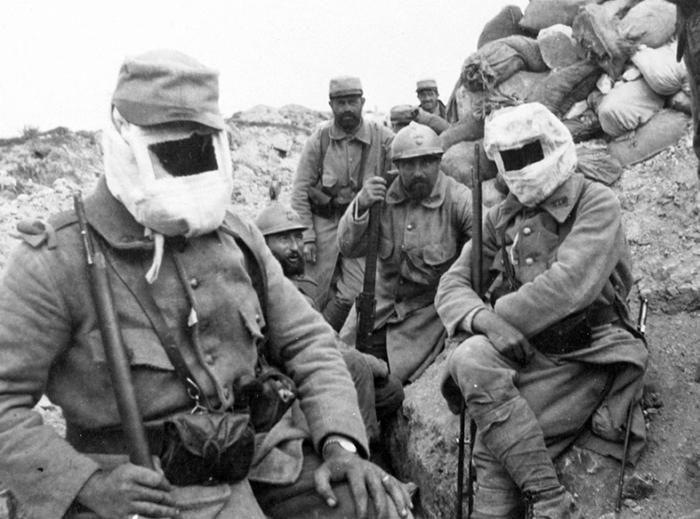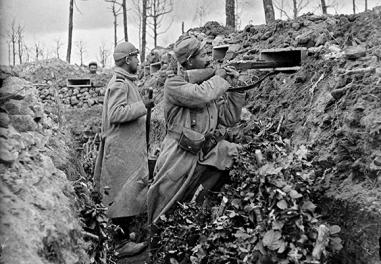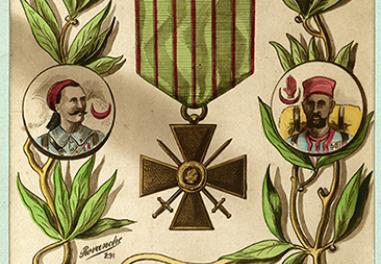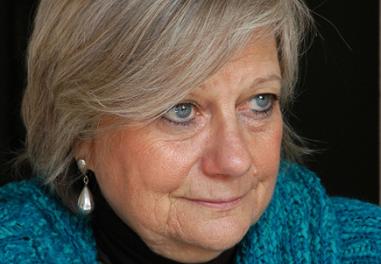The massive use of poison gas
On 22 April 1915, a threshold was crossed in war violence when the German high command decided to use toxic gas on Allied troops in front of Ypres. Colonel Mordacq, present at the scene, recounted this terrible day.

The Germans were to use poison gas fifty times from April 1915 to September 1917. In the spring of 1916, up to 500 tonnes of chemical substances were used and the following year yet another 300 tonnes were used during the same period. The most spectacular attack took place on 22 April 1915, between Bixschoote and Langemarck in Flanders.
In early 1915, the conflict got bogged down and army staff tried to imagine ways to break through the western front. After a first attempt on the Russian front which, due to the cold, proved inconclusive, the Germans decided to experiment the asphyxiating gas north of the Ypres salient
Previously, engineering units had dug first line trenches over a 7 to 8-kilometre long front and had installed over 5,800 pressurised cylinders (containing a total of 150 tonnes of chlorine). The filling station and the park company were located in Kortemarck 10 km further north. The attack was ordered for 17 hundred hours. The effect of the chlorine was immediate, almost indescribable. The first Allied lines fell back to get out of the suffocating atmosphere around them. The Germans, protected by their masks, advanced in compact rows and shot at those men who had not been floored by the gas.
About 30 minutes after the end of the toxic gas discharges, the German infantry advanced four kilometres.
"CERTAINLY, THE THOUGHT OF A GAS ATTACK NEVER ENTERED MY HEAD"
Here is an excerpt from the report for this day of 22 April 1915, giving an account of this first attack by gas. "Colonel Mordacq was preparing to leave when, around 5:20pm, he received a phone call from Commander Villevaleix (of the 1st Rifle Regiment). Coughing and croaking to such an extent that his voice was barely understandable he reported 'that he was being attacked heavily and that monstrous yellow pillars of smoke had been seen coming from the German trenches and spreading out to cover the entire area, that his men had begun to leave the trenches and were racing to the rear to escape; though many were suffocating and collapsing". "When I heard these words and the tone of his voice, I wondered for a moment if the Commander had lost his head or had been gripped by panic, something I had often seen at the start of the mobile war, especially during the battles around Chipotte in September 1914."
"Certainly, the thought of a gas attack never entered my head. I should never have believed it possible and I had never heard a whisper of any such thing ever since my arrival in Belgium. Almost at the same moment, I heard the sound of rapid rifle fire accompanied by the roar of the guns. Quite clearly, something unusual was going on and it could well be an attack. Almost simultaneously, I received another telephone call. This time from de Fabry, one of the commanding officers of the 1st Rifle Regiment who spoke in the same agitated way as Villevaleix and with the same intelligence, adding "that he would have to evacuate his command post. It was impossible to breathe; all around him entire sections had been knocked out either through suffocation or because they had fallen victim to the artillery fire which the enemy was bringing down on the reserve positions; the positions could be held no longer, they were caught between gas and shellfire". Finally, I received another telephone call from Commander Villevaleix: "Everyone is collapsing around me, I am leaving my command post", I could not catch the end of his sentence, then the telephone went dead. "
A SCENE WORTHY OF DANTE'S INFERNO
"Beyond the canal, individual yellowish clouds could be seen then, having proceeded to three or four hundred metres from Boezinge, we experienced a sharp prickling sensation in our noses and throats; our ears began to roar, breathing became difficult and we were overcome by the unbearable stench of chlorine. We had to dismount because the horses, suffering, refused to either gallop or trot. (...) On the outskirts of the village, the sight was really pitiful. Everywhere men were running for their lives: territorials, Africans, riflemen, zouaves, gunners without their weapons, haggard, holding the skirts of their open coats, their collars ripped open, they raced like madmen for safety. Crying out loudly for water, coughing up blood, some rolled on the ground in agony making desperate attempts to breathe. An African cried out for milk then seeing the colonel, exclaimed: "Colonel, these blackguards have poisoned us". In short, it was like a scene from Dante's inferno; though the Italian poet never described anything so appalling in his masterpiece. "Since the beginning of the war, we had seen panic alas in Lorraine and around Arras, but never before such a scene of utter desperation as unfolded in front of me.
It was out of the question to halt the fleeing troops. We did not even try. They were no longer soldiers, these poor fleeing beings who had been driven mad at a single stroke. It was the same all along both banks of the canal: ignoring the bullets and projectiles, masses of distraught men on both banks sought relief from their agonies in the water." (...) The Colonel also managed to query a few artillery officers who escaped from the turmoil and who, in the vicinity of the bridge, valiantly returned fire alongside the gunners they could muster up. Mad with anger, coughing blood, their eyes popping out of their heads, they reported that all their equipment had fallen into the hands of the Germans, and begged to immediately organise a counter-attack to get it back. But with whom and with what?
TOWARDS CHEMICAL WARFARE
The number of gas victims is difficult to assess accurately. Among the thousands of intoxicated men that day, the figures vary between 1,000 and 5,000 dead according to the sources. Approximately 5,000 men were taken prisoner. On the French side, it was not until February 1916 that the first gas attack took place. In all there were some 20 such attacks.
They took place along a five-kilometre front using 6,000 bottles of 'Bertolite' (chlorine) and were effective within a radius of 10 to 15 km. The coming of means of protection, troop training and discipline turned out to be the best way to counter this and contributed to limit recourse to this method of combat.
Read more
Bibliography :
Les grandes heures de la guerre. La guerre des Tranchées, Général Henri Mordacq, volume 2, Plon, Paris, 1939.
La Guerre des gaz 1915-1918, Paul Voivenel and Paul Martin, Giovanangeli, 2004
"La guerre des gaz de 1915 – 1918", 14-18 Le magazine de la Grande Guerre n° 38, Éditions Soteca SARL
Articles of the review
-
The file

The year 1915 – Putting an end to the trenches
The hecatombs of 1914 surprised and took aback senior army command. Once the front got bogged down, trench warfare turned out to be just as deadly as mobile warfare and did not enable any of the belligerents to gain a decisive upper hand. So how could you do away with the trenches and win this war a...Read more -
The figure

The Croix de Guerre is 100 years old
Right from the first battles in the summer of 1914, a shortcoming was quickly detected in the French system of rewarding deserving combatants. It was not until April 1915 that the Croix de Guerre was created which was then to become the very symbol of victorious First World War soldiers. Vidéo commé...Read more -
The interview

Nicole Buresi
Agrégée (holder of highest teaching diploma in France) in Literature and a playwright, this teacher ran a writer's workshop for six months on the Great War. Nicole Buresi told us about this joint work that culminated with the publication of a novel, Bassoles goes off to war.
Read more

